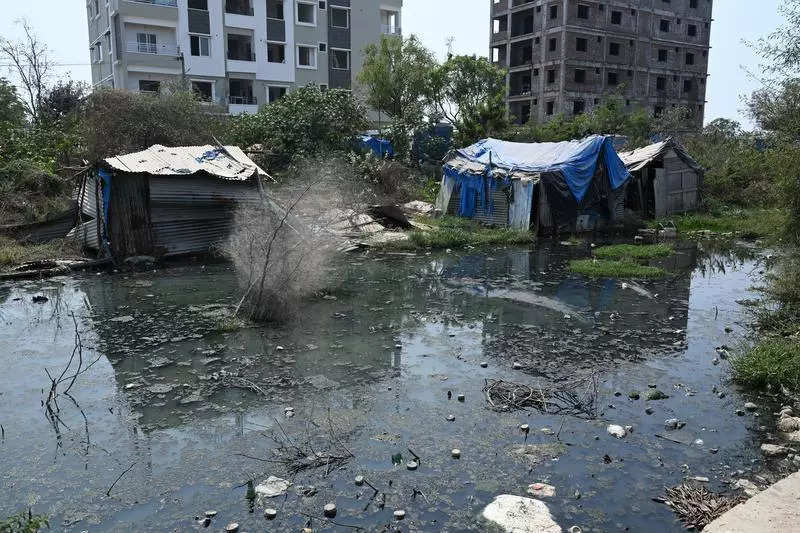Realty bloom in Nallagandla brings sewer water on roads | Hyderabad News

Hyderabad: Despite being one of the highest tax payers in the Greater Hyderabad region and witnessing a real estate boom with property values reaching 8,000 – 10,000 per sq ft, many localities in Nallagandla still lack basic sewerage infrastructure.
Several newly developed areas along the 100-foot road in Nallagandla towards Tellapur have no sewerage network, forcing residential buildings to discharge their effluent on the roadside, resulting in persistent foul odours.
In fact, the GHMC laid storm water drains while constructing the road in Nallagandla, but in the absence of a sewerage system, the effluent from the neighbouring houses pollutes this facility.
Residents of the gated community Aparna Sarovar in Nallagandla have raised concerns about sanitation. According to residents, around 20 independent apartment blocks do not have proper sewerage infrastructure and on-site sewage treatment plants (STPs) are dumping waste behind the gated community. This improper disposal has led to increased mosquito breeding in the area, they claim.
“Many apartments adjacent to our gated community dump their sewage near the back gate of the University of Hyderabad. Despite our regular fogging efforts, these measures are proving ineffective in combating this menace. Moreover, whenever we reach the ground floor, the residents have to endure a persistent stench emanating from these sewerage outlets,” said S Sai Kiran, a resident of Aparna Sarovar.
“The sewerage network in Nallagandla is in a deplorable state. Many houses and apartments dump their waste on the roadside. On the 100-foot road, in the absence of a sewerage network, many properties have created pits and roadside dumps, and when these temporary facilities overflow, they spill onto the roads, making the roads unfit for use,” said Gagaveen Reddy, a shopkeeper in Nallagandla.
As well as residents, over 700 schoolchildren also suffer from open drainage. Recently, the management of Sahiti Vidya Niketan High School, Nallagandla, wrote a letter to the GHMC pointing out that stagnant water from open drains emanating from commercial complexes on Tellapur Road has accumulated behind their school premises, causing stench and mosquito infestation.
“This situation is affecting the health of the school children. Despite notifying the plot owners, no remedial action has been taken,” said the school management, adding that during the monsoon, sewage water also seeps into their basement, further aggravating the situation.
According to the Hyderabad Metropolitan Water Supply and Sewerage Board (HMWSSB), an STP with a capacity of 7 MLD is being constructed on an area of 180 acres to meet the needs of the sewerage network in Nallagandla. “This will facilitate the establishment of trunk lines and comprehensive sewerage infrastructure. We are currently carrying out topographical surveys for additional sewerage lines. The elevated road level resulting from the recent road construction has posed a challenge for the implementation of new pipeline installations,” said a senior official of the HMWSSB.
Several newly developed areas along the 100-foot road in Nallagandla towards Tellapur have no sewerage network, forcing residential buildings to discharge their effluent on the roadside, resulting in persistent foul odours.
In fact, the GHMC laid storm water drains while constructing the road in Nallagandla, but in the absence of a sewerage system, the effluent from the neighbouring houses pollutes this facility.
Residents of the gated community Aparna Sarovar in Nallagandla have raised concerns about sanitation. According to residents, around 20 independent apartment blocks do not have proper sewerage infrastructure and on-site sewage treatment plants (STPs) are dumping waste behind the gated community. This improper disposal has led to increased mosquito breeding in the area, they claim.
“Many apartments adjacent to our gated community dump their sewage near the back gate of the University of Hyderabad. Despite our regular fogging efforts, these measures are proving ineffective in combating this menace. Moreover, whenever we reach the ground floor, the residents have to endure a persistent stench emanating from these sewerage outlets,” said S Sai Kiran, a resident of Aparna Sarovar.
“The sewerage network in Nallagandla is in a deplorable state. Many houses and apartments dump their waste on the roadside. On the 100-foot road, in the absence of a sewerage network, many properties have created pits and roadside dumps, and when these temporary facilities overflow, they spill onto the roads, making the roads unfit for use,” said Gagaveen Reddy, a shopkeeper in Nallagandla.
As well as residents, over 700 schoolchildren also suffer from open drainage. Recently, the management of Sahiti Vidya Niketan High School, Nallagandla, wrote a letter to the GHMC pointing out that stagnant water from open drains emanating from commercial complexes on Tellapur Road has accumulated behind their school premises, causing stench and mosquito infestation.
“This situation is affecting the health of the school children. Despite notifying the plot owners, no remedial action has been taken,” said the school management, adding that during the monsoon, sewage water also seeps into their basement, further aggravating the situation.
According to the Hyderabad Metropolitan Water Supply and Sewerage Board (HMWSSB), an STP with a capacity of 7 MLD is being constructed on an area of 180 acres to meet the needs of the sewerage network in Nallagandla. “This will facilitate the establishment of trunk lines and comprehensive sewerage infrastructure. We are currently carrying out topographical surveys for additional sewerage lines. The elevated road level resulting from the recent road construction has posed a challenge for the implementation of new pipeline installations,” said a senior official of the HMWSSB.
















